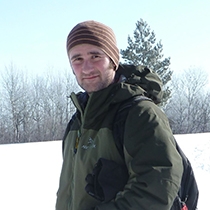

Dr Nic Minter
Biography
Animals and their environments have been interacting and modifying one another since life began. I am interested in co-evolution between life and the planet. I work at the interface among palaeontology, sedimentology and behavioural ecology; focussing on organism-substrate interactions and what they can tell us about the make-up of ecosystems through time and their responses to major events in the history of the Earth. These include evolutionary radiations, colonization events and mass extinctions.
Research interests
The study of organism-sediment interactions is a significant area of research on both a fundamental level, for understanding the evolution of animals and environments; and on an applied level, for delineating past and present habitats and environmental conditions, and providing insights for future challenges to society in predicting the impacts of ongoing environmental and biotic change on ecosystem functions and services.
My research involves field, lab, collections, and database studies. I have studied organism-substrate interactions ranging from half a billion years old through to conducting experiments with living animals, and across deep marine to desert environments. I have been fortunate enough to study world-renowned geological localities, including the Cambrian Burgess Shale of British Columbia, Carboniferous of Atlantic Canada, Permian Robledo Mountains of New Mexico, Triassic Petrified Forest National Park of Arizona, and Cretaceous Dinosaur Coast of Korea.
Research areas:
- The establishment of terrestrial ecosystems
- The Cambrian explosion and ecosystem engineering
- Refinement of ichnofacies models and palaeoenvironmental analysis
- Novel experimental methods and laboratory analysis of organism-substrate interactions
- Benthic-pelagic coupling and ecosystem functioning through time and space
- Bioturbation in submarine canyon systems
Research outputs
2025
Early colonization of the deep-sea bottom - the protracted build-up of an ecosystem
Buatois, L., Mángano, G., Paz, M., Minter, N., Zhou, K.
10 Feb 2025, In: Proceedings of the National Academy of Sciences. 122, 8, 18p., e2414752122
Research output: Article
Environmental and evolutionary controls in animal-sediment interactions at the onset of the Cambrian explosion
Gougeon, R., Buatois, L., Mángano, G., Narbonne, G., Laing, B., Paz, M., Minter, N.
20 Jan 2025, In: Current Biology. 35, 2, p. 249-264, 16p.
Research output: Article
2024
Bioturbators as ecosystem engineers in space and time
Mángano, G., Buatois, L., Minter, N., Gougeon, R.
18 Nov 2024, In: Palaeontology. 67, 6, 38p., e12732
Research output: Article
Identifying signatures of the earliest benthic bulldozers in emergent subaerial conditions during the colonization of land by animals
Wang, Z., Davies, N., Liu, A., Minter, N., Rahman, I.
6 Nov 2024, In: Proceedings of the Royal Society B: Biological Sciences. 291, 2034, 20241629
Research output: Article
Fish trails and imprints
Minter, N.
8 Feb 2024,
Research output: Chapter (peer-reviewed)
2023
A review of the glacial environment arthropod trace fossils Umfolozia and Warvichnium with the description of new ichnotaxa
De Barros, G., Peixoto, B., Lima, J., Minter, N., Sedorko, D.
14 Sep 2023, In: Papers in Palaeontology. 9, 5, 35p., e1526
Research output: Article
2022
Bioturbators as ecosystem engineers: assessing current models
Laing, B., Buatois, L., Mángano, G., Minter, N., Strotz, L., Narbonne, G., Brock, G.
29 Dec 2022, In: Palaios. 37, 12, p. 718-730
Research output: Article
Neoichnology of amphibious arthropods: effects of subaqueous and subaerial substrate conditions on trace morphology
Devine, L., Minter, N.
20 Oct 2022, In: Palaios. 37, 10, p. 585-605, 21p.
Research output: Article
Names for trace fossils 2.0: theory and practice in ichnotaxonomy
Bertling, M., Buatois, L., Knaust, D., Laing, B., Mángano, G., Meyer, N., Mikulas, R., Minter, N., Neumann, C., Rindsberg, A., Uchman, A., Wisshak, M.
20 Oct 2022, In: Lethaia. 55, 3, p. 1-19, 19p.
Research output: Article
The invasion of the land in deep time: integrating Paleozoic records of paleobiology, ichnology, sedimentology, and geomorphology
Buatois, L., Davies, N., Gibling, M., Krapovickas, V., Labandeira, C., MacNaughton, R., Mángano, G., Minter, N., Shillito, A.
1 Aug 2022, In: Integrative and Comparative Biology. 62, 2, p. 297-331, 35p.
Research output: Article
